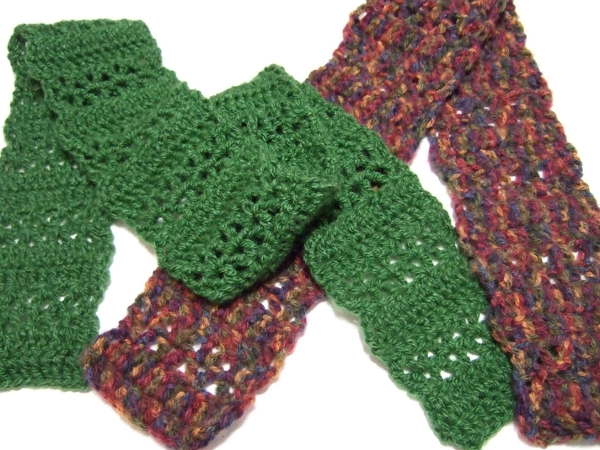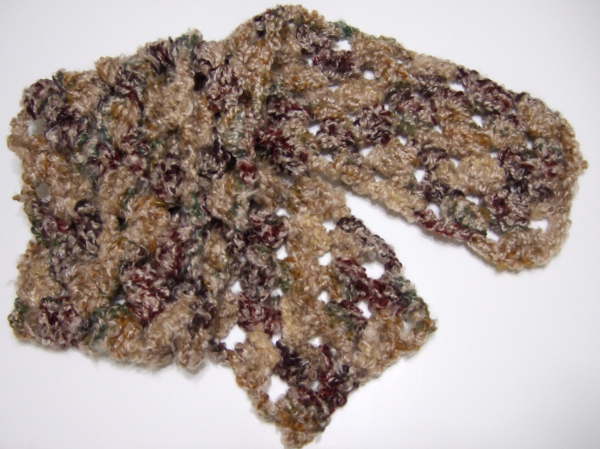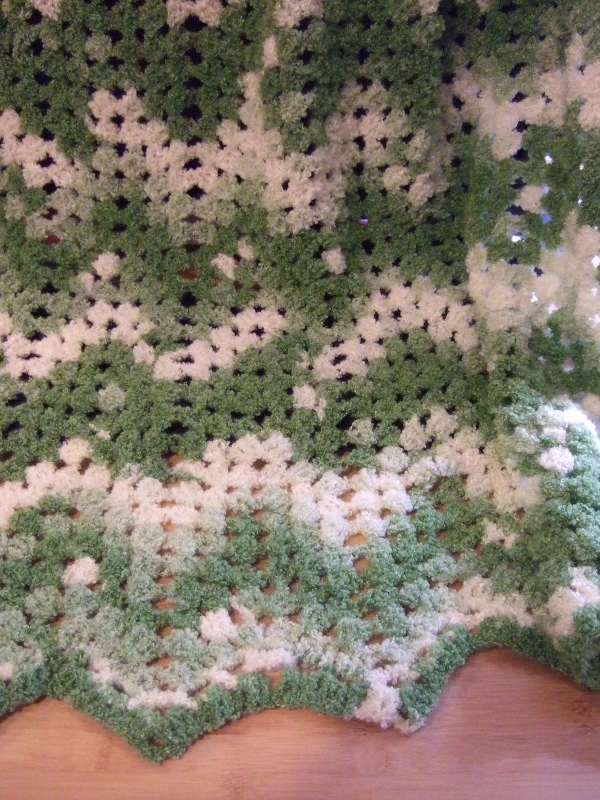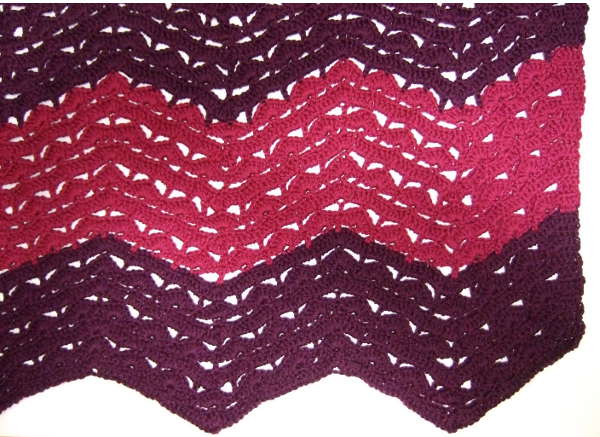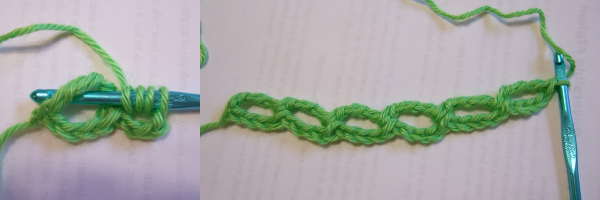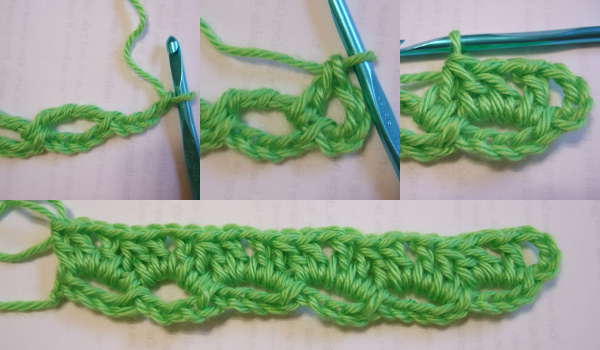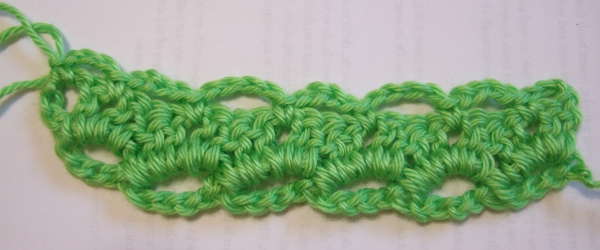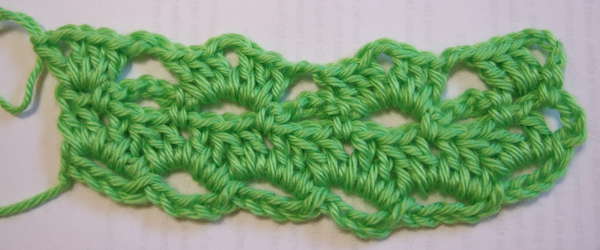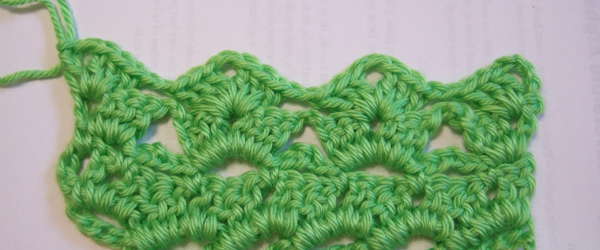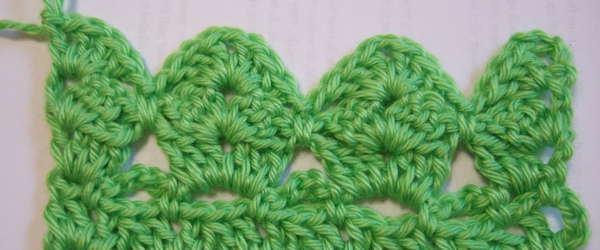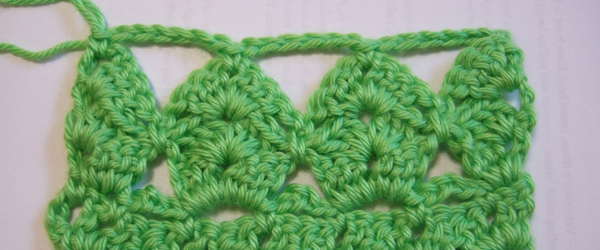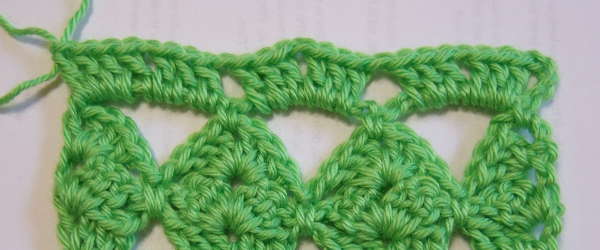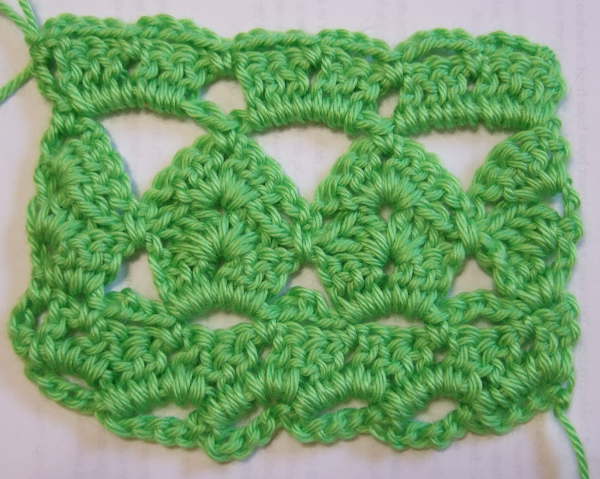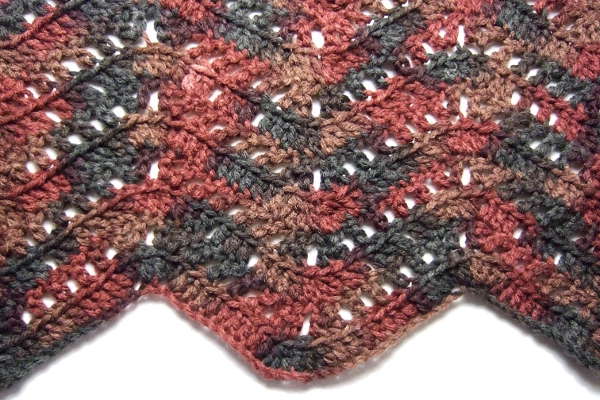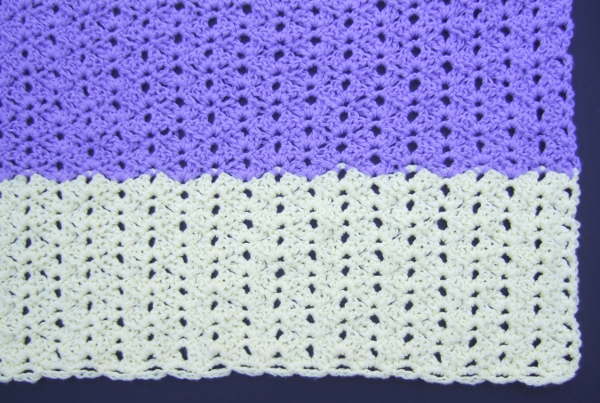
This free-style afghan is a great way to use up little bits of leftover yarn while making a stunning conversation piece. The diamond inserts transition the ripple pattern from a smaller ripple to a larger one and then back to a smaller one again. The diamond inserts can also be stacked to create a patchwork look.
The example is made in light worsted weight mercerized cotton.
Since this is a design-your-own style afghan, this pattern is presented as patterns for the individual sections and construction guidelines. This is not a traditional pattern with beginning to end instructions. It is not a beginning project. ATTEMPT AT YOUR OWN RISK.
Size:
This blanket can be made any size. Five widths are given in the directions.
| Size | Width (Inches) | Length (Inches) | Ounces of yarn | Yards of yarn |
| Extra Small | 29.77 | 39.7 | 17.9 | 922.82 |
| Small | 39 | 52 | 30.71 | 1583.3 |
| Medium | 48.23 | 64.3 | 46.96 | 2420.99 |
| Large | 57.45 | 76.6 | 66.65 | 3435.89 |
| Extra Large | 66.68 | 88.90 | 89.77 | 4627.99 |
Materials:
Worsted weight yarn (see chart for amount)
Size H (5mm) crochet hook
Abbreviations:
ch = chain
ch sp = chain space
dc = double crochet
hdc = half double crochet
sl st = slip stitch
Special stitches:
dc3tog – double crochet 3 stitches together (uses three stitches, decreases by two stitches) – [Yarn over, insert hook in next stitch, yarn over and pull up loop, yarn over, draw through 2 loops] 3 times (4 loops on hook), yarn over, draw through all loops on hook.
dc5tog – double crochet 5 stitches together (uses five stitches, decreases by four stitches) – [Yarn over, insert hook in next stitch, yarn over and pull up loop, yarn over, draw through 2 loops] 5 times (6 loops on hook), yarn over, draw through all loops on hook.
The beginning chain should be a multiple of 44 plus 10.
For these widths, start with this number of chains:
29.75″ = 142
39″ = 186
48.25″ = 230
57.5″ = 274
66.75″ = 318

Begin with Small Ripple A.
Row 1: Dc in 4th ch from hook, dc in next 2 ch, 3 dc in next ch, dc in next 8 ch, dc5tog (uses next 5 ch), dc in next 8 ch, ** 5 dc in next ch, dc in next 8 ch, dc5tog (uses next 5 ch), dc in next 8 ch. Repeat from ** to last 4 ch. 3 dc in next ch, dc in next 3 ch.
Row 2: Ch 3, turn. Dc in 2nd dc, dc in next dc, 3 dc in next dc, dc in next 8 dc, dc5tog (uses 2 dc, dc5tog, 2 dc), dc in next 8 dc, ** 5 dc in next dc, dc in next 8 dc, dc5tog (uses 2 dc, dc5tog, 2 dc), dc in next 8 dc. Repeat from ** to last 3 dc and turning chain. 3 dc in next dc, dc in next 2 dc, dc in top of turning chain.
Repeat row 2.
Small Ripple B: Ch 3, turn. Dc in 2nd dc, dc in next dc, dc3tog (uses dc3tog, 2 dc), dc in next 8 dc, 5 dc in next dc, dc in next 8 dc, dc5tog (uses 2 dc, dc5tog, 2 dc), dc in next 8 dc, 5 dc in next dc, dc in next 8 dc, ** dc5tog (uses 2 dc, dc5tog, 2 dc), dc in next 8 dc, 5 dc in next dc, dc in next 8 dc. Repeat from ** to last 5 stitches and turning chain. dc3tog (uses 2 dc and dc3tog), dc in next 2 dc, dc in top of turning chain.
These two will be front and back of the same section.
Big Ripple A: Ch 3, turn. Dc in 2nd dc, dc in next dc, 3 dc in next dc, dc in next 8 dc, dc5tog (uses 2 dc, dc5tog, 2 dc), dc in next 19 dc, 5 dc in next dc, ** dc in next 19 dc, dc5tog (uses 2 dc, dc5tog, 2 dc), dc in next 19 dc, 5 dc in next dc. Repeat from ** to last 13 stitches and turning chain. Dc in next 8 dc, dc3tog (uses 2 dc and dc3tog), dc in next two dc, dc in top of turning chain.
Big Ripple B: Ch 3, turn. Dc in 2nd dc, dc in next dc, dc3tog (uses dc3tog and 2 dc), dc in next 8 dc, 5 dc in next dc, dc in next 19 dc, dc5tog (uses 2 dc, dc5tog, 2 dc), ** dc in next 19 dc, 5 dc in next dc, dc in next 19 dc, dc5tog (uses 2 dc, dc5tog, 2 dc). Repeat from ** to last 11 dc and turning chain. Dc in next 8 dc, 3 dc in next dc, dc in next 2 dc, dc in top of turning chain..
Big Ripple C: Ch 3, turn. Dc in 2nd dc, dc in next dc, dc3tog(uses dc3tog, 2 dc), dc in next 19 dc, 5 dc in next dc, dc in next 19 dc, ** dc5tog (uses 2 dc, dc5tog , 2 dc), dc in next 19 dc, 5 dc in next dc, dc in next 19 dc. Repeat from ** to last 5 stitches and turning chain. dc3tog (uses 2 dc and dc3tog), dc in next 2 dc, dc in top of turning chain.
Basic Diamond:
Row 1: Form a slip knot, find the stitch that is 11 stitches before the center bottom stitch and slip stitch the slip knot to it. Ch 3, dc in the next 8 stitches, dc5tog (uses 2 dc, dc5tog, 2 dc), dc in next 9 dc.
Row 2: Ch 3, turn. Dc in second dc, dc in next 5 dc, dc5tog (uses 2 dc, dc5tog, 2 dc), dc in next 7 dc.
Row 3: Ch 3, turn. Dc in second dc, dc in next 3 dc, dc5tog (uses 2 dc, dc5tog, 2 dc), dc in next 5 dc.
Row 4: Ch 3, turn. Dc in second dc, dc in next dc, dc5tog (uses 2 dc, dc5tog, 2 dc), dc in next 3 dc.
Row 5: Ch 3, turn. Skip first dc, dc5tog (uses 2 dc, dc5tog, 2 dc), dc in next dc. Fasten off and secure.
Right side half diamond:
Row 1: On last stitch of prior row, before pulling through last two loops of last stitch, change to diamond yarn and pull through. Ch 3, turn. Dc in second dc, dc in next dc, dc3tog (uses dc3tog and 2 dc), dc in next 9 dc.
Row 2: Ch 3, turn. Dc in second dc, dc in next 5 dc, dc3tog (uses 2 dc and dc3tog), dc in next 2 dc, dc in top of turning ch.
Row 3: Ch 3, turn. Dc in second dc, dc in next dc, dc3tog (uses dc3tog and 2 dc), dc in next 4 dc, dc in top of turning ch.
Row 4: Ch 3, turn. Dc in second dc, dc in next dc, dc3tog (uses 2 dc and dc3tog), dc in next 2 dc, dc in top of turning ch.
Row 5: Ch 3, turn. Dc in second dc, dc in next dc, dc3tog (uses dc3tog and 2 dc), dc in top of turning ch.
Row 6: Ch 1, turn. Sl st in dc3tog, Hdc in next dc, dc in next dc, dc in top of turning ch.
Pull finally loop out a bit and secure. Complete other diamonds across and then make color change on this last stitch for next section.
Left side half diamond:
Row 1: Form a slip knot, find the stitch that is 11 stitches before the dc3tog stitch and slip stitch the slip knot to it. Ch 3, dc in the next 8 stitches, dc3tog (uses 2 dc and dc3tog), dc in next 2 dc, dc in top of turning ch.
Row 2: Ch 3, turn. Dc in second dc, dc in next dc, dc3tog (uses dc3tog and 2 dc), dc in next 6 dc, dc in top of turning ch.
Row 3: Ch 3, turn. Dc in second dc, dc in next 3 dc, dc3tog (uses 2 dc and dc3tog), dc in next 2 dc, dc in top of turning ch.
Row 4: Ch 3, turn. Dc in second dc, dc in next dc, dc3tog (uses dc3tog and 2 dc), dc in next 2 dc, dc in top of turning ch.
Row 5: Ch 3, turn. Skip first dc, dc3tog (uses 2 dc and dc3tog), dc in next 2 dc, dc in top of turning ch.
Row 6: Ch 3, turn. Dc in second dc, hdc in next dc, sl st in dc3tog. Fasten off and secure.
Construction Tips:
At the end of each section, extend the last loop and secure it. Once diamonds are completed between the sections, if the next section is going to be the same color as the previous, just pick up and continue with the reserved loop. If a color change is desired, pull loop back and insert hook back into last two loops of last stitch of the row. Knot new color close to work. Yarn over with new color and pull through both loops.
After completing a ripple section, turn the work as though to start the next row. Start the diamonds on this side.
The first row of a ripple section will be worked on the sides of diamonds. When making stitches, make a stitch in the same stitch that the first stitch of the first row of the diamond was made and in the same stitch that the last stitch of the first row of the diamond was made. Make two stitches over each dc or ch 3 on the sides of the diamonds. Make a stitch in the dc5tog at the top of each diamond.
Examples:
Going from small ripple to big ripple – diamonds will be placed in every other “valley”. The edge stitches of the first row of the diamonds will be in the center dc of the 5dc at the top of the adjacent “peaks”. The big ripple has a dc5tog in the valley of the small ripple and then has 19 dc. The first 8 dc are in dc stitches. The next dc is in the same dc as the first stitch of the diamond. The next 10 dc are along the side of the diamond, with 2 dc over each dc or ch 3 that form the edge of the diamond (5 rows of the diamond with 2 dc in each make up the 10 dc). The 5 dc in one stitch for the peak will be in the dc5tog of the diamond. For the 19 dc going back down to the valley, 10 will be along the other side of the diamond, 1 in the same dc that the end stitch of the first row of the diamond, and then 8 in dc continuing along the small ripple. That should bring you to 2 dc before the dc5tog in the valley.
Going from a big ripple to a small ripple – diamonds will be placed in every deep “valley”. The small ripple will have 8 dc coming down from the big ripple. At the valley there will be 2 dc and then a stitch that has an edge stitch of a diamond. To make the dc5tog for the small ripple valley, you will use 2dc, the shared dc, and make the last two parts over the edge dc or ch 3 of the diamond. The remaining 4 rows of the diamond give you 4 edge dc and ch 3 spaces to make 2 dc each to form the 8 dc climbing to the peak of the small ripple. The 5 dc will be worked in the dc5tog at the top of the diamond. The 8 dc coming down to the next valley will be in the dc and ch 3 spaces along the side of the diamond for the first 4 rows. The dc or ch 3 sp on the side of the first row of the diamond, the shared stitch and 2 dc will make up the dc5tog of the valley.
Convert from one type of small ripple to the other by putting a diamond in every valley. The edge stitches of the diamonds will share the center stitch of the 5 dc of the peak of the ripple.
Diamonds can also be made on other diamonds to make fields of diamonds. Just follow the basic rules as established above to keep stitch counts consistent.



